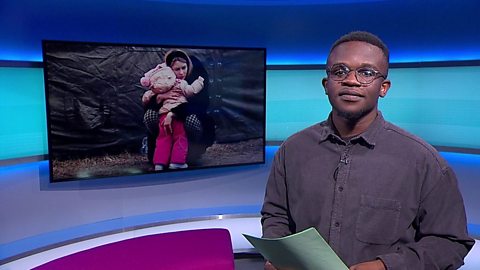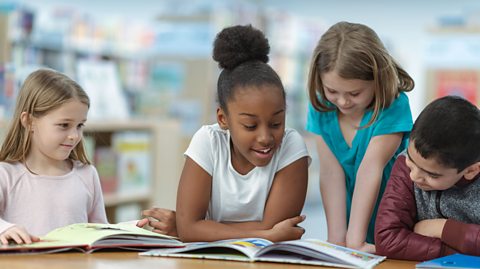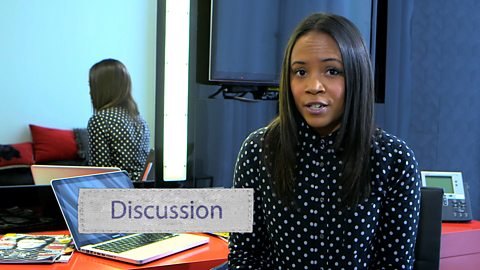ΒιΆΉΤΌΕΔ Teach > Teacher Support > Articles
By Catherine Weir
Primary school teacher and education consultant
This article was first published in March 2022 and updated in February 2023.

As the war in Ukraine reaches its first anniversary, teachers are faced with the challenge of children in their class seeking answers.
Do you embrace questions from your class about current news stories or is it something you dread come discussion time? Newsround can help teachers approach such situations with confidence as well as keeping young viewers up to date with latest events happening around the world.
Here are four ways Newsround can help teachers talk about the news:
1. Tackling hard-hitting news head on
Having the chance to hear a news report in class can be a much-anticipated part of childrenβs daily routine. The Russian invasion of Ukraine is an example of a current world event which needs to be discussed, but finding the right approach is not an easy task for any teacher. To discuss such a broad, devastating topic in the limited time of a busy school day seems like a mammoth task. You know your class best and will know what level of discussion is most appropriate for them. First of all, I would assess their understanding of the war in general and what they have seen and heard already.
Classroom conversations could be initiated by displaying the Ukrainian and Russian flags and asking your class if they have seen them before. Routines such as circle time should be used if children are already aware that this is a safe space to talk and can follow the classβs circle time rules. Do any of the children have links to the military or family links to Ukraine? For such children, a small group or one-to-one conversation may be less overwhelming.
It is important to remember that as educators, we must remain impartial and not present our own, or anyone elseβs, views as fact. Pave the way for discussion by tapping into the guides, live news bulletins, articles, videos and images Newsround has to offer. Age-appropriate language and the lack of jargon will help to ensure children are able to build an accurate understanding of complex events.
Discussions can be further enhanced by the article βWar in Ukraine: What do all the words mean?' β offering clear explanations of tricky words. Key words from this article, a map of Ukraine and the Ukrainian flag could be placed on a news bulletin board to add to the sense of familiarity with current news.


2. Demystifying key images and stories online
Lots of children see the faces of key political figures, such as Vladimir Putin, in the media and are unsure of who they are. Accessing Newsround content such as: 'Vladimir Putin: Who is the Russian President, and what does he want?' and βUkraine invasion: Who is Volodymyr Zelensky?β means children will gain an understanding of the people behind the photographs.
Encourage older pupils to research the answers together and watch some of Newsroundβs video collection, to ensure the information theyβre accessing is factually accurate. Newsroundβs collection will also provide a focus for your class which other video sharing sites may not. For younger children, offer a scaled-down explanation through circle time or when they are drawing or playing a game.
Provide a time for reflection in the school day around fake news with 'How to spot misleading stories online about the Ukraine crisis' and encourage parents/caregivers from your class to carry on the conversation at home. As teachers, it is ok not to have the answer there and then, or feel overwhelmed ourselves at the questions being asked.

3. Help the children in your class manage their worries
As all educators know, distressing news stories may be too much for some pupils to comprehend, and may impact on their mental health. The Newsround article 'Advice if you're upset by the news' has tips which should provide comfort - especially for children who may feel the news stories they hear will affect their family directly.
As we know, some children are a closed book and bottle up their feelings. Implement a colour-coded worry box in your classroom. Worries can be discussed either in a one-to-one conversation with a trusted adult in school, or shared with the class anonymously during a discussion. As you may have already encountered, questions based around an impending world war, conscription and Britainβs involvement in the conflict are to be expected from children at this time. Reinforce that these feelings/thoughts are normal and although Britain and the Unites States support Ukraine, they are not sending their own troops to the country.
Some children may be happy with the information given, can process it and move on. However, others may need lots of reassurance β perhaps asking the same question repeatedly.
As teachers, we spend a large proportion of our time validating feelings, making sure children donβt feel ignored, judged or criticised. For more anxious children, I would reiterate that it is natural to have such feelings, that they are shared with many other children and the fact that they are thinking about such matters shows that they have an insight into the world around them. Children can be supported to talk back to a worry in their head, write it down for the worry box or teachers can encourage their parent/caregiver to carry on the conversation with them at home.
Offer further reassurance that many people, including world leaders, are working together to find peace β supported by the Newsround article 'Ukraine refugees: What's being done to help?' Mention to your class that they can also help children during these difficult times. Ask how they could help the children in Ukraine. Empowerment is key and this could be through raising money as a school or collecting clothes, books and toys to send to a local donation hub.
4. Spark interest and creativity for writing
Newsround puts world news into context for young audiences, making it accessible for all. Using it more often in the classroom will help familiarise children with news reporting formats, and can encourage reluctant writers to put pen to paper. Harness childrenβs interest in current events by using Newsroundβs various articles as models for writing and build class success criteria. Analyse how Newsround is presented and encourage pupils to try similar models and techniques when presenting what they have written.
Widen the vocabulary of children in your class by exploring the article 'Newsround: Top headlines and new words of the day'. Set a challenge for children to include the new daily words in a writing task or in a conversation with a friend.
To mark one year since the Russian invasion of Ukraine, the Newsround team has made Ukraine: The Children's Story, a special film recorded in the north of the country which looks at the lives and perspectives of the young people affected by the war. See it on CΒιΆΉΤΌΕΔ on Wednesday 22 March at 7.55am, or after broadcast on iPlayer.
The Newsround Live Lesson which marked the programmes' 50th anniversary in 2022 is still available to view, which takes a curriculum-based look on putting news stories together.
You can find more helpful Newsround resources here.
CΒιΆΉΤΌΕΔ Newsround. collection
The home of news and fun facts for kids. Find out what is going on, with stories, pictures and videos.

World Book Day 2023 β Live Lesson: Thursday 2 March, 11:00. document
We'll be celebrating the joy of books, authors and reading for pleasure in a World Book Day lesson for 7-11 year-olds.

English KS1 / KS2: The Facts About Non-Fiction. collection
With the help of some well-known faces, these short films for primary schools are designed to help pupils make their non-fiction writing the best it can be.
